Apps
Auto Added by WPeMatico
Auto Added by WPeMatico
Google has announced changes to the licensing model for its Android mobile operating system in Europe, including introducing a fee for licensing some of its own brand apps, saying it’s doing so to comply with a major European antitrust ruling this summer.
In July the region’s antitrust regulators hit Google with a recordbreaking $5BN fine for violations pertaining to Android, finding the company had abused the dominance of the platform by requiring manufacturers pre-install other Google apps in order to license its popular Play app store.
Regulators also found Google had made payments to manufacturers and mobile network operators in exchange for exclusively pre-installing Google Search on their devices, and used Play store licensing to prevent manufacturers from selling devices based on Android forks.
Google disputes the Commission’s findings, and last week filed its appeal — a legal process that could take years. But in the meanwhile it’s making changes to how it licenses Android in Europe to avoid the risk of additional penalties heaped on top of the antitrust fine.
Hiroshi Lockheimer, Google’s senior vice president of platforms & ecosystems, revealed the new licensing options in a blog post published today.
Under updated “compatibility agreements”, he writes that mobile device makers will be able to build and sell Android devices intended for the European Economic Area (EEA) both with and without Google mobile apps preloaded — something Google’s same ‘compatibility’ contracts restricted them from doing before, when it was strictly either/or (either you made Android forks, or you made Android devices with Google apps — not both).
“Going forward, Android partners wishing to distribute Google apps may also build non-compatible, or forked, smartphones and tablets for the European Economic Area (EEA),” confirms Lockheimer.
However the company is also changing how it licenses the full Android bundle — which previously required OEMs to load devices with the Google mobile application suite, Google Search and the Chrome browser in order to be able to offer the popular Play Store — by introducing fees for OEMs wanting to pre-load a subset of those same apps under “a new paid licensing agreement for smartphones and tablets shipped into the EEA”.
Though Google stresses there will be no charge for using the Android platform itself. (So a pure fork without any Google services preloaded still wouldn’t require a fee.)
Google also appears to be splitting out Google Search and Chrome from the rest of the Google apps in its mobile suite (which traditionally means stuff like YouTube, the Play Store, Gmail, Google Maps, although Lockheimer’s blog post does not make it clear which exact apps he’s talking about) — letting OEMs selectively unbundle some Google apps, albeit potentially for a fee, depending on the apps in question.
“[D]evice manufacturers will be able to license the Google mobile application suite separately from the Google Search App or the Chrome browser,” is what Lockheimer unilluminatingly writes.
Perhaps Google wants future unbundled Android forks to still be able to have Google Search or Chrome, even if they don’t have the Play store, but it’s really not at all clear which configurations of Google apps will be permitted under the new licensing terms, and which won’t.
“Since the pre-installation of Google Search and Chrome together with our other apps helped us fund the development and free distribution of Android, we will introduce a new paid licensing agreement for smartphones and tablets shipped into the EEA. Android will remain free and open source,” Lockheimer adds, without specifying what the fees will be either.
“We’ll also offer new commercial agreements to partners for the non-exclusive pre-installation and placement of Google Search and Chrome. As before, competing apps may be pre-installed alongside ours,” he continues to complete his trio of poorly explained licensing changes.
We’ve asked Google to clarify the various permitted and not permitted app configurations, as well as which apps will require a fee (and which won’t), and how much the fees will be, and will update this post with any response.
The devil in all those details should become clear soon though, as Google says the new licensing options will come into effect on October 29 for all new (Android based) smartphones and tablets launched in the EEA.
Powered by WPeMatico
Twitter today inserts activity-based tweets into your timeline, alerting you to things like the popular tweets liked by people you follow, or those Twitter accounts that a lot of people in your network have just started to follow. These alerts can be useful, but their timing is sporadic and they can be easily missed. Plus, if you turn off Twitter’s algorithmic timeline (as may be possible for some), you’ll lose access to this sort of info. A new Twitter app called Macaw aims to help.
Macaw, which recently launched on Product Hunt, offers a set of similar information as Twitter does, with a few changes.
Macaw works by first pulling in a list of people you follow. It then tracks what tweets they like throughout the day and turns that into a feed of tweets that were most popular. Macaw does the same thing for users, too – that is, it shows you if a number of people have suddenly started following someone, for example.
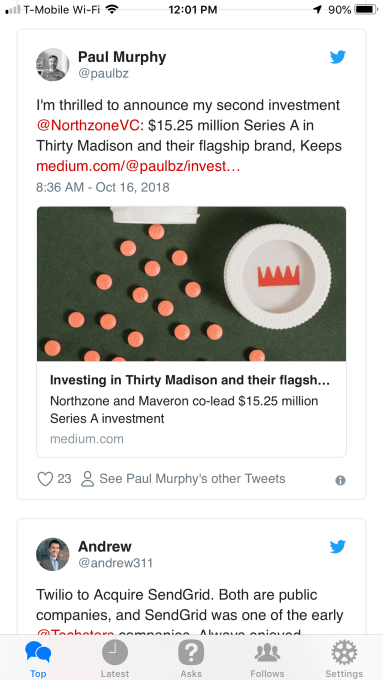
Beyond this, Macaw will also show you the “Latest” tweets receiving likes from your network in a separate tab, as well as tweets where someone has asked a question.
This “Asks” section will highlight tweets where someone on Twitter has asked something like “Does anyone know…?” or “what are the best…?”, for example. This can help you find new conversations to participate in and help you expand your network.
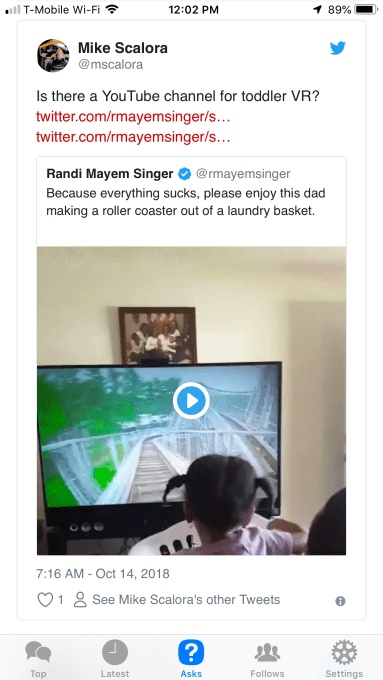
The end result is a curated version of Twitter, where you can catch up with what’s important, without so much endless scrolling through your timeline.
Even if you’re on Twitter itself a lot, Macaw can still be useful.
Its default setting will hide top tweets posted by someone in your network – because, chances are, you’ve already read them. With this setting turned on, you’ll only be shown top tweets by users you don’t yet follow.
You can also configure how many likes are required for something to be considered a “top” tweet. By default, this is set to 25, but you can change it to 10, 100, or even 1,000. You can adjust the default setting for the age of the tweet, too, from 6 hours to 2 hours, 24 hours, or 96 hours, based on how often you check in.
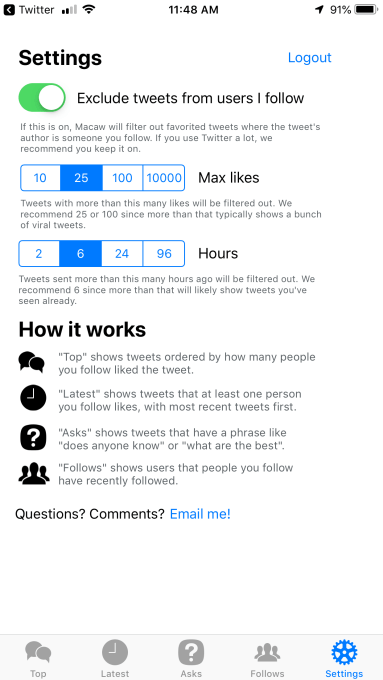
The app, however, is not a Twitter client.
That is, it doesn’t take the place of Twitter or other apps like Twitterific or Tweetbot, as you can’t use it to post tweets, access direct messages, update your profile, or follow users. You’ll need a different app, like the main Twitter client, for that. But a tap in Macaw will launch Twitter for you, making the transition feel seamless.
The app was built by Zachary Hamed, who had previously built Daily 140 for tracking a similar set of data, shared via email. He says he started building Macaw as a side project and launched it into private beta in August. It doesn’t currently have a business model, beyond a plan to maybe charge for additional features later on.
In some ways, Macaw is similar to Nuzzel, another Twitter summarization app that provides a list of top links that your network is sharing and discussing. But many of the best things on Twitter aren’t links, they’re individual tweets or tweetstorms. (Like that recent Google+ rant, for example).
Hamed admits Nuzzel was a source of inspiration for Macaw (a bird that screams constantly, by the way. Ha!)
“I was actually inspired by those notifications in the main Twitter app since I’ve always found them fascinating and by Nuzzel, which is one of my most used apps – and whose founder Jonathan I really respect,” Hamed says. “I think there is a lot of hidden insight to be found in posts people have liked and who they start following, especially if there is momentum around certain names or topics. As of now, Twitter only shares one to two of those recommendations, not all of it,” he adds.
*While we do like Macaw, the app, one thing we’re not a fan of are the fake reviews on the Macaw website, which pretend to be from @Jack, Mary Meeker, and Chamath Palihapitiya. It’s obviously meant to be a joke, but it falls flat – Macaw doesn’t need this sort of false promotion, and it’s wrong because it could confuse less savvy users.
Macaw is a free download on the App Store.
Powered by WPeMatico
If you’ve been laying off the Pokémon GO for a while due to a lack of new monsters, prepare to be glued to your phone again. Niantic is now adding pokémon from the rugged Sinnoh region that first appeared in 2007’s Diamond, Pearl and Platinum games.
Of course, it’s not so simple as a dump of a hundred new ‘mon into your area. The new guys are arriving in waves, likely meaning the most common sorts will start appearing today, while cooler ones and sets of themed critters will arrive over the coming weeks.
These are part of the Generation 4 set, but it’s not clear yet which will be appearing first or indeed at all. It’s entirely up to Niantic and you can be sure they’re going to mete out these little guys over several months, interspersed with other events — anything to keep you catching.
Everyone will probably have a Chimchar on their shoulder soon, because that sucker is cute, but ultimately everyone is going to want a Dialga. I get the feeling they’re going to be a regular feature at gyms soon. I for one will be working to evolve a Glaceon.
There are also some new evolutions, so don’t trash your mid-tier pokémon just yet. Magmortar, Electivire, Tangrowth and Rhyperior mean you’ll have a use for all that extra candy.
Update your app and start draining that battery, Trainer! And don’t forget that we’ve got Niantic’s Ross Finman at our AR/VR Session in LA this Thursday. Drop by if you’re in the area.
Powered by WPeMatico
Dating app Hinge is today launching a new feature aimed at improving its recommendations, based on whether or not matches had successful real-world dates. The feature may also help to address one of the major problems with today’s dating apps: that no one knows how well they actually work. After all, it’s one thing to get matches and have conversations, but it’s quite another to turn those into dates, much less a long-term relationship.
With a new feature called “We Met,” Hinge will ask users a few days after they shared their phone numbers if they went on a date, and, if so, if they’d want to see that person again. This data will be used as a signal to inform Hinge’s algorithms and improve matches, if the user later returns to the app.
During beta trials, Hinge says that 90% of members said their first dates were great, and 72% said they wanted to go on a second.

“Ultimately, if you went on a date with someone and you thought they were great, that’s the strongest signal that we’ve gotten very close to your type of person. So if there are more people like that person, we can show them to you,” says Hinge CEO Justin McLeod.
By “like that person” it’s not a matter of physical appearance or some sort of profile categorization, to be clear.
“You can’t really aggregate people into their component pieces and try to crack what’s someone’s ideal person,” McLeod explains.
Instead, Hinge uses collaborative filtering – people who like X also like Y – to help inform its matches on that front.
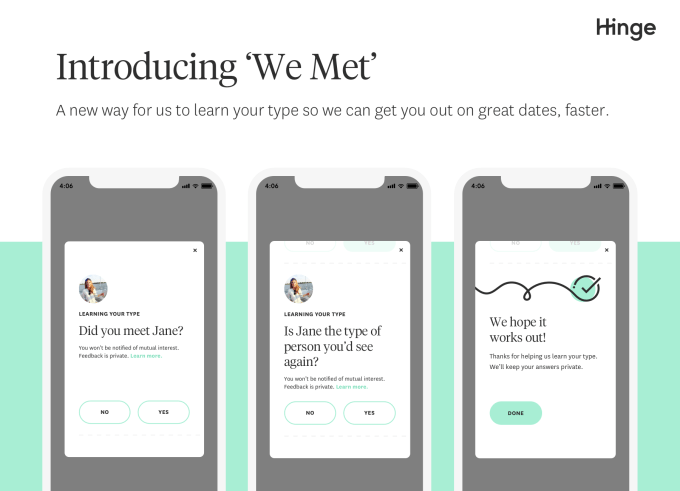
With the launch of We Met, Hinge will now know when dates succeed or fail, and eventually, perhaps, why. It also plans to combine the We Met data with other signals – such as, whether users become inactive in the app or delete their accounts, as well as email survey data – to figure out which dates may have turned into relationships.
This is something of a first for the dating app industry, which is today incentivized to keep users “playing” their matching games, and spending money on in-app subscriptions – not leave them. It’s not in dating apps’ financial interest, at least, to create relationships (i.e., heavy user churn).
This influences the dating apps’ design – they don’t tend to include features designed to connect people in real life.
For example, they don’t make suggestions of events, concerts, and other things to do; they don’t offer maps of nearby restaurants, bars, coffee shops, or other public spaces for first dates; they don’t offer built-in calling (or gamify unlocking a calling feature by continuing to chat in app); they don’t use in-app prompts to suggest users exchange numbers and leave the app. Instead, apps tend to push users to chat more – with things like buttons for adding photos and GIFs, or even tabs for browsing Facebook-style News Feeds.
The problem of wasting time chatting in dating apps has now become so prevalent that many users’ profiles today explicitly state that they’re “not looking for pen pals.”
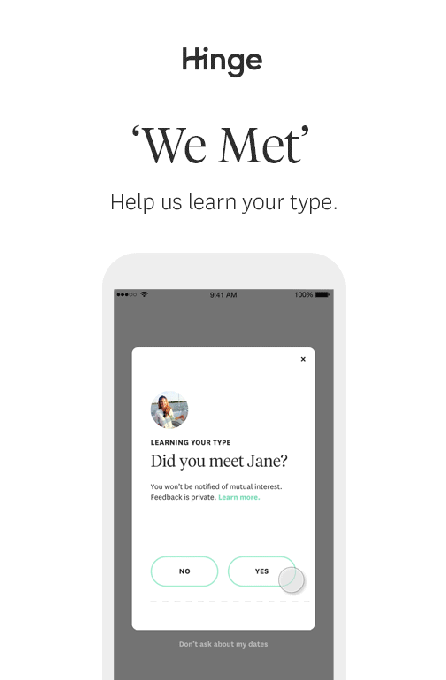
Of course dating apps – just like any other way of meeting new people – will have their share of success stories. Everyone knows someone who met online.
But claims that, for example, Tinder is somehow responsible for a whole generation of “Tinder babies” are hugely suspect, because the company doesn’t have any way of tracking if matches are actually dating, and certainly not if they end up getting married and having kids. It even said so in a recent documentary.
All Tinder has – or any of these companies, really – are anecdotes and emails from happy couples. (And this, of course, should be expected, with user bases in the tens of millions, like Tinder.)
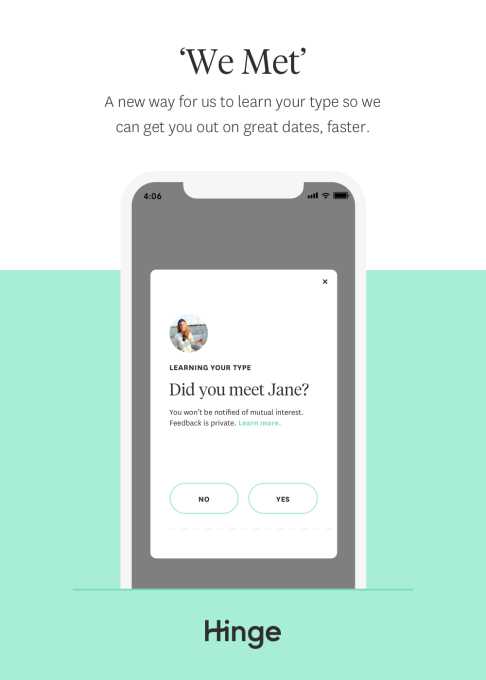
We Met, meanwhile, is actually focused on quantifying real world dating successes in Hinge, not in-app engagement. Longer term, it could help to establish Hinge as place that’s for people who want relationships, not just serial dates or hookups.
The feature is also another example of how Hinge is leveraging A.I. combined with user insights to improve matches. Recently, it rolled out a machine learning-powered feature, Most Compatible, to help provide users with daily recommendations based on their in-app activity.
Hinge says We Met will launch today, October 16, on iOS first. Android will soon follow.
Powered by WPeMatico
Instacart chief executive officer Apoorva Mehta wants every household in the U.S. to use Instacart, a grocery delivery service that allows shoppers to order from more than 300 retailers, including Kroger, Costco, Walmart and Sam’s Club, using its mobile app.
Today, the company is taking a big leap toward that goal.
San Francisco-based Instacart has raised $600 million at a $7.6 billion valuation, just six months after it brought in a $150 million round and roughly eight months after a $200 million financing that valued the business at $4.2 billion.
D1 Capital Partners, a relatively new fund led by Daniel Sundheim, the former chief investment officer of Viking Global Investors, led the round.
Instacart is raking in cash aggressively but spending it cautiously. The company still has all of its Series E, which ultimately totaled $350 million, and the majority of its $413 million Series D in the bank, a source close to the company told TechCrunch. That means, in total, Instacart has $1.2 billion at its fingertips. Currently, according to the same source, the company is only profitable on a contribution margin basis, meaning it’s earning a profit on each individual Instacart order.
In a conversation with TechCrunch, Mehta said the company didn’t need the capital and that it was an “opportunistic” round, i.e. the capital was readily available and Instacart has ambitious plans to scale, so why not fundraise. Instacart plans to use the enormous pool of capital to double its engineering team by 2019, which will include filling 300 open engineering roles in its recently announced Toronto office, he said.
As far as an initial public offering, it will happen — eventually.
“It will be on the horizon,” Mehta told TechCrunch.
“2018 has been a really big year for us,” he added. “The reason why we are so excited is because the opportunity ahead of us is enormous. The U.S. is a $1 trillion grocery market and less than 5 percent of that is bought online. It’s an enormous category that’s highly under-penetrated.”
In the last six months, Instacart has announced a few notable accomplishments.
As of August, the service has been available to 70 percent of U.S. households. That’s due to the expansion of existing partnerships and new deals entirely, like a recently announced pilot program between Instacart and Walmart Canada that gives Canadian Instacart users access to 17 different Walmart locations across Winnipeg and Toronto, Ontario.
The company has also completed several executive hires. Most recently, it tapped former Thumbtack chief technology officer Mark Schaaf as CTO. Before that, Instacart brought on David Hahn as chief product officer and Dani Dudeck as its first chief communications officer.
In early September, the company confirmed its chief growth officer Elliot Shmukler would be leaving the company.
The six-year-old Y Combinator graduate has raised more than $1.6 billion in venture capital funding from Coatue Management, Thrive Capital, Canaan Partners, Andreessen Horowitz and several others.
Powered by WPeMatico
The charmingly outdated media player Winamp is being reinvented as a platform-agnostic mobile audio app that brings together all your music, podcasts and streaming services to a single location. It’s an ambitious relaunch, but the company behind it says it’s still all about the millions-strong global Winamp community — and as proof, the original desktop app is getting an official update as well.
For those who don’t remember: Winamp was the MP3 player of choice around the turn of the century, but went through a rocky period during Aol ownership (our former parent company) and failed to counter the likes of iTunes and the onslaught of streaming services, and more or less crumbled over the years. The original app, last updated in 2013, still works, but to say it’s long in the tooth would be something of an understatement (the community has worked hard to keep it updated, however). So it’s with pleasure that I can confirm rumors that substantial updates are on the way.
“There will be a completely new version next year, with the legacy of Winamp but a more complete listening experience,” said Alexandre Saboundjian, CEO of Radionomy, the company that bought Winamp (or what remained of it) in 2014. “You can listen to the MP3s you may have at home, but also to the cloud, to podcasts, to streaming radio stations, to a playlist you perhaps have built.”
“People want one single experience,” he concluded. “I think Winamp is the perfect player to bring that to everybody. And we want people to have it on every device.”
Now, I’m a Winamp user myself. And while I’ve been saddened by the drama through which the iconic MP3 player and the team that created it have gone (at the hands of TechCrunch’s former parent company, Aol), I can’t say I’ve been affected by it in any real way. Winamp 2 and 5 have taken me all the way from Windows 98 SE to 10 with nary a hiccup, and the player is docked just to the right of this browser window as I type this. (I use the nucleo_nlog skin.)
And although I bear the burden of my colleagues’ derisive comments for my choice of player, I’m far from alone. Winamp has as many as a hundred million monthly users, most of whom are outside the U.S. This real, engaged user base could be a powerful foot in the door for a new platform — mobile-first, but with plenty of love for the desktop too.
“Winamp users really are everywhere. It’s a huge number,” said Saboundjian. “We have a really strong and important community. But everybody ‘knows’ that Winamp is dead, that we don’t work on it any more. This is not the case.”
This may not come as a shock to Winamp users still plugged into the scene: Following years of rumors, an update to the desktop player leaked last month, bringing it from version 5.666 to 5.8. It was a pleasant surprise to users who had encountered compatibility problems with Windows 10 but had taken the “more coming soon” notice on the website with a massive grain of salt.
This kind of thing happens a lot, after all: an old property or app gets bought, promises are made and after a few years it just sort of fades away. So a free update — in fact, 5.8 eliminates all paid options originally offered in the Pro version — bringing a bucketful of fixes is like Christmas coming early. Or late. At any rate it’s appreciated.
The official non-leaked 5.8 release should come out this week (the 18th, to be precise), and won’t be substantially different from the one we’ve been using for years or the one that leaked. Just bug and compatibility fixes that should keep this relic trucking along for a few years longer.
The update to the desktop app is basically a good faith advance payment to the community: Radionomy showing they aren’t just running away with the property and slapping the brand on some random venture. But the real news is Winamp 6, which Saboundjian says should come out in 2019.
“What I see today is you have to jump from one player to another player or aggregator if you want to listen to a radio station, to a podcast player if you want to listen to a podcast — this, to me, is not the final experience,” he explained. It’s all audio, and it’s all searchable in one fashion or another. So why isn’t it all in one place?
The planned version of Winamp for iOS and Android will be that place, Saboundjian claims. On desktop, “the war is over,” he said, and between the likes of iTunes and web apps, there’s not much room to squeeze in. But mobile audio is fractured and inconvenient.
While Saboundjian declined to get into the specifics of which services would be part of the new Winamp or how the app would plug into, say, your Spotify playlists, your Google Music library, your Podcasts app, Audible and so on, he seemed confident that it would meet the needs he outlined. There are many conversations underway, he said, but licensing and agreements aren’t the main difficulty, and of course release is still quite a ways out. The team has focused on creating a consistent app across every platform you might want encounter mobile audio. A highly improved search will also play a role — as it ought to, when your media is all lumped into one place.
No word on whether it will retain its trademark intro upon installation — “WINAMP. It really whips the llama’s ass.” I certainly hope so.
This lack of specifics is a bit frustrating, of course, but I’m not worried about vaporware. I’m worried that other services will insist on the fragmented experience they’ve created that serves their interests better than ours. But if Radionomy can navigate these tricky waters and deliver a product even a little like what they’ve described, I’ll be thrilled (and my guess is tens of millions more will be, as well). And if not, well, we’ll always have the original.
Powered by WPeMatico
The app for hiking enthusiasts just secured a big round of capital that will help it map more trails worldwide.
AllTrails has raised $75 million, led by Spectrum Equity, which has taken a majority stake in the company in the process. Founded in 2010, AllTrails raised a small amount of capital years ago from investors, including 2020 Ventures and 500 Startups. It was also part of AngelPad’s inaugural accelerator class. This is its first sizeable round of equity financing.
AllTrails provides what it calls an “outdoors platform” that includes crowdsourced reviews of trails from its community of 9 million avid hikers, mountain bikers and trail runners in more than 100 countries. It also provides detailed trail maps and other content tailor-made for outdoorsy folk. The company says its app has been downloaded more than 12 million times.
AllTrails was founded by Russell Cook, who has since left to launch another fitness tech startup called FitOn. The company is now led by Jade Van Doren, who joined as CEO in September 2015.
“I grew up camping in the Sierras with my grandfather and backpacking up there,” Cook told TechCrunch. “I looked around the space and it felt like there was a lot of room to build something meaningful that would help people find places to get outdoors and feel safe once they are out there.”
“I got really excited about doing that and we’ve made a lot of progress toward those goals,” he added. “I enjoy waking up in the morning and knowing what we are building is helping people live healthier and more active lifestyles.”
Cook said the business is cash flow positive and wasn’t seeking a venture capital infusion when Spectrum approached. He says their expertise in the consumer space — the firm also has investments in Ancestry, WeddingWire and several others — will be a big value-add for AllTrails.
In addition to expanding overseas, the company will use the capital to hire aggressively.
As part of the deal, Spectrum’s Ben Spero and Matt Neidlinger will join AllTrails’ board of directors.
Powered by WPeMatico
AI-powered photo management app Zyl is going back to the drawing board with a streamlined, more efficient redesign. The app is now focused on one thing only — resurfacing your old memories.
Taking photos on a smartphone is now a daily habit. But what about looking back at photos you took one year, three years or even eight years ago? It can pile up quite quickly. Zyl thinks there’s emotional value in those long-forgotten photos.
Before this update, Zyl helped you delete duplicates, create smart photo albums based on multiple criteria and collaborate on photo albums. In other words, it was a utility app.
But when the company started talking with some of their users, they realized that one feature stood out and had more value than the rest.
Applying those AI-powered models to your photo library is a great way to find interesting photos. But nobody was really looking at them.
When you open the app, you get a view of your camera roll with your last photos at the bottom. There’s also a big green button at the bottom. When you tap on it, Zyl creates a satisfying animation and unveils an important photo.
If you took multiple photos to capture this moment, the app stitches together those photos and create a GIF. You can then share this Zyl with a friend or family member.
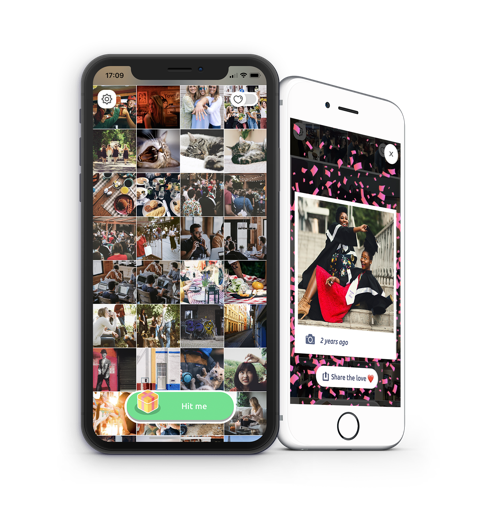
But the true magic happens if you try to get another Zyl. You have to wait 24 hours to unlock another photo. The next day, the app sends you a notification when your photo is ready. You can always open the app again and look at your past Zyls in a new tab with your most important photos.
Unlike Timehop or Facebook’s “On This Day” feature, Zyl doesn’t look at your social media posts and focuses on your camera roll. Zyl isn’t limited to anniversaries either.
Just like before, Zyl respects your privacy and leaves your photos alone. They’re never sent to the company’s server — Zyl uses the same photo database as the native one on your iPhone or Android phone so it doesn’t eat up more storage.
Over time, the app could give you more options by leveraging facial recognition and the intrinsic social graph of your photo library. Maybe you want to see more photos of your brother as his wedding is coming up.
And that notification can be a powerful nudge. I keep opening the app and sharing old photos. Zyl is a good example of the combination of something that you care about combined with an element of surprise.

Powered by WPeMatico
This summer, Facebook launched Fb.gg, its online gaming hub and Twitch competitor, designed to attract game streamers and their fans to watch videos on Facebook instead of on rival sites. The destination shows videos based on which games and streaming celebrities users follow, plus Liked Pages and Groups, and other featured suggestions of what to watch. Now, Fb.gg is expanding to mobile with its launch on Android.
The new app, first spotted by Sensor Tower, arrived just a few days ago and is currently in beta testing.
According to its description on Google Play, the app allows gamers and fans to discover a “universe of gaming content,” connect with creators and join communities, and play instant games like Everwing, Words with Friends, Basketball FRVR, and others.
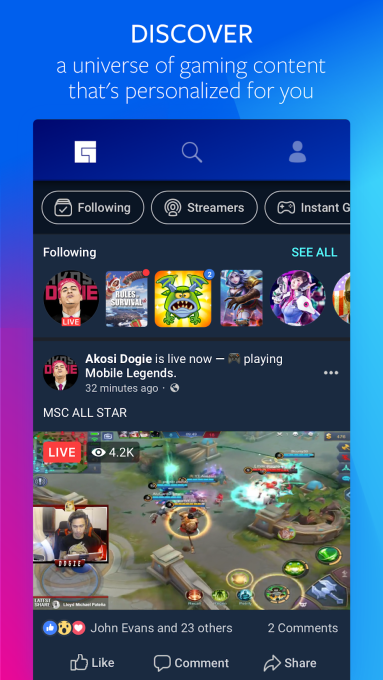
From the screenshots, you can see how the Fb.gg app lets users tap navigation buttons at the top to find streamers to watch, or to view those streamers they’re already following, among other things. They can also participate in live conversations during gameplay with other viewers. Here, they can react to the stream using Facebook’s standard emoticon set of likes, hearts, haha’s and others.
Another section lets gamers jump into simple and popular mobile games. These titles are among those who were early participants in Facebook’s other gaming efforts in the past, like Instant Games on Facebook and Messenger.

Facebook has been trying to woo the gaming community for some time, to better compete against Amazon’s Twitch and Google’s YouTube. There’s a large and growing market for game streaming and viewing, with young viewers tuning in an average of 3+ hours a week to watch, as TechCrunch previously noted.
Facebook’s efforts to directly challenge Twitch and others kicked off in earnest this year, with the launch of its own version of Twitch’s Partner Program. Facebook’s gaming creator pilot program, as it’s called, allows viewers to tip their favorite gamers. And with the arrival of Fb.gg in June, the virtual currency involved in those tips was being referred to as Facebook Stars, with each star equating to $0.01.
Facebook said it takes a cut of fans’ purchases of stars, ranging from 5%-30%, depending on what size pack is bought.

Facebook also recently began testing a monthly subscription option with game streamers, similar to what’s offered by YouTube and Twitch.
Of course, to truly compete with Twitch and YouTube, Facebook needs to go mobile as well – especially since the upcoming Messenger redesign will hide away extraneous features, like mobile gaming. That’s where Fb.gg’s app comes in.
The Android version of the Fb.gg beta app launched on October 9, and already has over 10,000 installs, according to Google Play.
“We recently started testing a standalone gaming app on Google Play that builds on the experience of fb.gg, our destination on Facebook for people to find gaming content in one place,” a Facebook spokesperson told TechCrunch. “The fb.gg app is currently in beta with a limited set of features and available in the Philippines. We’re using the beta phase to get feedback from the gaming community and will make a decision on whether we roll it out further based on that response,” they said.
Update, here are some screenshots, courtesy of Twitter user Monte Thigpen:
Beta is exclusively in Philippines but here are some screenshots I got pic.twitter.com/kU3NeK6nGi
— Monte Thigpen
✪ (@mot427) October 12, 2018
Powered by WPeMatico
Mobile ticketing app TodayTix is getting into the show production business with the launch of a new program called TodayTix Presents.
While TodayTix is sometimes described as the mobile version of the TKTS booth where you can pick up last-minute tickets to Broadway shows, CEO Brian Fenty said that he sees the service’s real competitors as “anything you can do with your night, outside of work — that’s Netflix and ‘Orange is the New Black,’ that’s post-season baseball, that’s a pitcher of margarita.”
At the same time, Fenty said after driving a total of $250 million in sales and to 4.6 million customers, the company has built a rich trove of data about people’s cultural interests. So with that in mind, it made sense for TodayTix to follow Netflix’s footsteps with “the same ethos that they had, to develop and to nurture programming and content that’s intimately connected to what users and what customers want to see.”
This doesn’t mean TodayTix is going to be producing spectacular Broadway productions. Instead, Fenty pointed to the TodayTix Live concert in Brooklyn last month as the first of these shows.
That concert, which celebrated TodayTix’s five-year anniversary and was hosted by Darren Criss, featured (mostly) Broadway stars like Matthew Morrison and Ariana Debose, who (mostly) performed pop standards.
Fenty said future TodayTix Live events won’t follow the exact same format, but the idea is to continue featuring popular artists in intimate settings — he compared it to “MTV Unplugged.” In fact, he suggested that with 300 attendees, last month’s concert was about as big as these shows will get.
And because these are small, one-off events, Fenty said they’re not competitive with the big shows that TodayTix works with.
“[Our partners] are doing longform, high-budget, highly developed shows that take years to develop and are fully baked,” he said. “Really what TodayTix Presents is supposed to be is a work-in-progress, an intimate way to see an artist.”
TodayTix already has plans for another New York City event in November, and then two in December. Fenty said “the cadence should roughly be a few events per quarter to start,” and that there will be shows across the service’s 13 markets.
Powered by WPeMatico